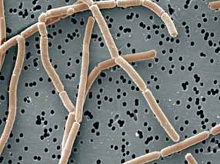Owning a dog changes a lot of things for people, but one thing you might not think about is how it changes the dust inside your home. It's true, the composition of the dust in dog owner's home is actually different than that of the dust found in a pet-free home, and researchers believe that exposure to this ‘dog dust’ may actually reduce the development of allergies and asthma in children. Could it be that dogs are proving themselves to be ‘man's best friend’ all over again? And if so, how?
_Over the last year or two, researchers have paid closer attention to the microbes living on and in us, and how these things can dramatically affect our lives, particularly when it comes to immune responses. Published this week in the Proceedings of the National Academy of Sciences, new research suggests an interesting link between exposure to dog-associated house dust and the subsequent development of allergic diseases like asthma and allergies, and interestingly enough, at the middle of this research is a very specific type of gut bacteria, Lactobacillus johnsonii.
_ During the our first few years of life, we begin to develop a very diverse microbiome of bacteria (think of a microbiome as a community of bacteria living inside your gastrointestinal system), and from immune responses to metabolism, these tiny inhabitants are proving to be critical in the development of allergic disease. In this instance, researchers tested dog-associated dust exposure as well as simple supplementation of Lactobacillus johnsonii into the gut.
During the our first few years of life, we begin to develop a very diverse microbiome of bacteria (think of a microbiome as a community of bacteria living inside your gastrointestinal system), and from immune responses to metabolism, these tiny inhabitants are proving to be critical in the development of allergic disease. In this instance, researchers tested dog-associated dust exposure as well as simple supplementation of Lactobacillus johnsonii into the gut.
_When exposed to the ‘dog dust’, the pre-adult mice showed less response to an airway allergen challenge, fewer activated T cells and reduced Th2 cytokine expression, all key indicators of allergic response. For another set of mice who weren't exposed to the dust, but instead had the numbers of Lactobacillus johnsonii in their gastrointestinal system supplemented orally (think – they gave the mice a Lactobacillus johnsonii probiotic), similar but not as strong results appeared. This second set of mice showed that while increased number of the Lactobacillus johnsonii bacteria in the gut did correlate with fewer allergic reactions and less allergic response, this correlation was much stronger in the mice who were exposed to dog-associated house dust. This seems to show that while that specific microorganism is helpful, a greater diversity in the microbiome also plays a role in immune system development and protection against allergic disease.
_The results are just another step in process of unraveling allergic disease, but is a truly critical one for two reasons. First, researchers were able to identify a very specific microorganism that shows a strong link to preventing the development of allergic disease. Secondly, the ‘dog dust’ shows that not only did it lead to increased level of this beneficial microorganism but also helped promote a more diverse array of microbes living in the intestinal system, and that as other research has suggested, this variety is also import in preventing the development of allergic disease.
_Undoubtedly, more attention and research will continue, and maybe soon, the link between allergic disease and the tiny microbes around us can become clear enough to begin devising ways to actually reduce the chances of children developing asthma and allergies in the first place! Wouldn't that be something?br>
_To read the full PDF of the research or for more condensed abstract.
On a side note, I discovered, Nestle (the food company, which consequently has a research facility in Switzerland) is responsible for the genetic sequencing of this bacterium, Lactobacillus johnsonii and uses it in some of its probiotic products.
_Author: K. Gilmore
